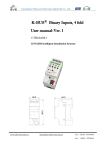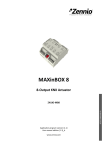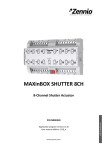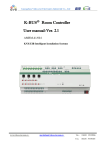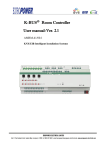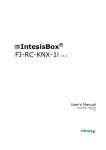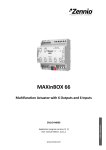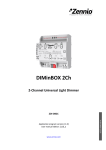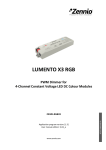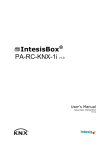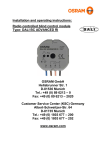Download Technical Manual
Transcript
8 channel EIB RF receiver GW 10 798 GW 12 798 GW 14 798 Technical Manual Summary 1 2 Introduction................................................................................................................................................. 3 Application .................................................................................................................................................. 4 2.1 Limits to the associations .................................................................................................................... 4 3 “Channel x ” menu ...................................................................................................................................... 5 3.1 Parameters.......................................................................................................................................... 5 3.2 Communication objects....................................................................................................................... 7 4 “Switching” function .................................................................................................................................... 8 4.1 Parameters.......................................................................................................................................... 8 4.2 Communication objects....................................................................................................................... 9 5 “Priority command” function ..................................................................................................................... 10 5.1 Parameters........................................................................................................................................ 10 5.2 Communication objects..................................................................................................................... 11 6 “Dimmer” function ..................................................................................................................................... 12 6.1 Parameters........................................................................................................................................ 12 6.2 Communication objects..................................................................................................................... 13 7 “Shutter” function ...................................................................................................................................... 14 7.1 Parameters........................................................................................................................................ 14 7.2 Communication objects..................................................................................................................... 15 8 “Sensors alarm” function .......................................................................................................................... 16 8.1 Parameters........................................................................................................................................ 16 8.2 Communication objects..................................................................................................................... 17 9 “Scene” function ....................................................................................................................................... 18 9.1 Parameters........................................................................................................................................ 18 9.2 Communication objects..................................................................................................................... 19 10 “Commands sequence” function........................................................................................................... 20 10.1 Parameters .................................................................................................................................... 20 10.2 Communication objects ................................................................................................................. 21 11 "8/16 bit value sending" function........................................................................................................... 24 11.1 Parameters .................................................................................................................................... 24 11.2 Communication objects ................................................................................................................. 25 2 1 Introduction This manual describes the functions of the devices named GW1x798 “8 channel EIB RF receiver” and how to use the ETS configuration software to change the settings and configurations. 3 2 Application The 8 channel EIB RF receiver is a system that allows the Chorus RF system command and control devices to communicate with a KNX/EIB system, which hence allows the Building Automation Konnex system to be extended using RF control devices. This device is in fact fitted with 8 EIB output channels, each of which can be configured independently to perform different functions; the functions each channel is able to perform are those typical to an input interface, that is ON/OFF commands, shutter control, dimmer control, scene management, priority commands, command sequences, 8/16 bit value sending commands and sensor alarm management. Not all RF control devices can perform the above listed functions, so before starting to configure the device using the ETS software, please read the INSTALLATION AND USER MANUAL, which lists all the commands that the different RF control devices can perform. This manual refers solely to the configuration using the ETS software. Please refer to the INSTALLATION AND USER MANUAL supplied with the product for instructions on how to configure the RF Receiver with RF control devices. 2.1 Limits to the associations The maximum number of logical associations that the device is able to memorize is 100; this means that the maximum number of logical connections between communication objects and group addresses is 100. The maximum number of group addresses that the device is able to memorize is 100; this means that it is possible to associate the communication objects to a maximum of 100 group addresses. 4 3 “Channel x ” menu This chapter describes the parameters and the communication objects relative to all 8 channels (hereinafter referred to generally as channel x) as seen in Diag. 3.1. The value set for the first option (Matched function) determines the structure of the entire menu, except for the Block enabling option (and consequently the other Block activation value and Block object start value options visible if the block is activated) and the Battery alarm object enabling options that are always displayed. Diag. 3.1 3.1 Parameters ¾ 3.1.1 Matched function This determines the function matched to the general channel x; according to the value of these settings, the Channel x menu will behave differently. The settings are: • no function No function is matched to the general channel x, consequently it can not be used. • switching See Chapter 4 - “switching” function • priority command See Chapter 5 - “priority command” function • dimmer See Chapter 6 - “dimmer” function • shutter See Chapter 7 - “shutter” function 5 • sensors alarms See Chapter 8 - “sensors alarms” function • scene See Chapter 9 - “scene” function • commands sequence See Chapter 10 - “commands sequence” function • 8/16 bit value sending See chapter 11 - “8/16 bit value sending ” function ¾ 3.1.2 Block enabling This allows you to enable the possibility to block the individual channels on the device, that is it prevents the sending of any commands associated to the changes in the contact status; the settings are: • disabled The block function is not enabled and consequently the Block activation value and Block object start value options are not visible. • enabled The block function is enabled by the Ch.x - Block communication object and it is possible to activate it using a bus command; when it is enabled, no changes in the status will be interpreted until the block cancellation command is received. ¾ 3.1.3 Block activation value This is used to set what logic value is used to activate the block function; the settings are: • “0” value When the device receives a telegram from the bus with a “0” logic value, it activates the block function. When the device receives a telegram with a “1” logic value, it disables the block function; if it was already disabled the command is ignored. • “1” value When the device receives a telegram from the bus with a “1” logic value, it activates the block function. When the device receives a telegram with a “0” logic value, it disables the block function; if it was already disabled the command is ignored. ¾ 3.1.4 Block object start value This is used to set what logic value the Ch.x - Block communication object must assume each time the bus power is reinstated; the settings are: • “0” value Each time the bus power is reinstated (29 Volt SELV) the device, on completing the initialisation phase, sets the logic value on the Ch.x - Block communication object to “0”; if this is also the block activation value, once the bus power is reinstated the device is “blocked”, if the block activation value is “1” the device will be “unblocked” and will behave normally. • “1” value Each time the bus power is reinstated (29 Volt SELV) the device, on completing the initialisation phase, sets the logic value on the Ch.x - Block communication object to “1”; if this is also the block activation value, once the bus power is reinstated the device is “blocked”, if the block activation value is “0” the device will be “unblocked” and will behave normally. ¾ 3.1.5 Battery alarm object enabling This allows you to enable the possibility to send a bus telegram with the battery status of the last RF control device associated to the general channel x that transmitted it; the settings are: 6 • disabled The battery status alarm is not sent and the relative Ch.x – Low battery alarm communication object is not visible. • enabled The battery status of the last RF control device associated to general channel x is sent via bus telegram; the relative Ch.x – Low battery alarm communication object is therefore visible. 3.2 Communication objects The Block enabling and Battery alarm object enabling options in the Channel x menu, if enabled, make the following communication objects visible (See Diag. 3.2.): Diag. 3.2 ¾ 3.2.1 Ch.x - Block Using this communication object, the device is able to receive the block switching on/off commands from the bus. The enabled flags are C (communication) and W (written by bus). The standard format of the object is 1.003 DPT_Enable, so the size of the object is 1 bit and the information it receives is block switching on/off . ¾ 3.2.2 Ch.x - Low battery alarm This communication object enables the device to send a bus telegram with the battery status of the last RF control device associated to the general channel x that transmitted it. The device sends a telegram with a "0" logic value when the battery is charged, and sends a telegram with a "1" logic value when a low battery status is acknowledged and needs replacing. The enabled flags are C (communication) and W (written by bus). The standard format of the object is 1.002 DPT_Bool, so the size of the object is 1 bit and the information it receives is low battery alarm true/false . 7 4 “Switching” function This function allows you to enable the general channel x to send on/off commands to the actuators that control the loads. Diag. 4.1 shows the channel x menu with the switching matched function, where you will notice the other configuration items that refer to the same function are not visible (the parameters relative to the Block enabling and Battery alarm object enabling options were already illustrated in the general section). Diag. 4.1 4.1 Parameters There are no parameters to be configured for the following function. 8 4.2 Communication objects The communication objects enabled by the switching function are those seen in Diag. 4.2. Diag. 4.2 ¾ 4.2.1 Ch.x - Switch Using these communication objects, the device sends ON/OFF commands to the bus after receiving load activation/deactivation commands from the RF control devices associated to the general channel x. The enabled flags are C (communication), R (read by bus) and T (transmission) . The standard format of the object is 1.001 DPT_Switch, so the size of the object is 1 bit and the information it sends is On/Off or more generally 1/0. 9 5 “Priority command” function This function allows you to enable the general channel x to send On/Off forced positioning commands to the actuators that control the loads. The diagram (Diag. 5.1) below shows the parameters that define the behaviour of the individual channels (the parameters relative to the Block enabling and Battery alarm object enabling functions were already illustrated in the General Section). Diag. 5.1 5.1 Parameters ¾ 5.1.1 Priority command Here you can configure the type of command to be sent when an activate forced positioning command is received from RF control devices; the settings are: • off/up When a forced positioning command is received from the RF control devices associated to the general channel x, the device sends an OFF forced positioning telegram to the bus, which for a general actuator means a forced “OFF” command, whilst for a motor control actuator it means a forced “UP (all UP)” command is sent to the controlled load. • on/down When a forced positioning command is received from the RF control devices associated to the general channel x, the device sends an ON forced positioning telegram to the bus, which for a general actuator means a forced “ON” command, whilst for a motor control actuator it means a forced “DOWN (all DOWN)” command is sent to the controlled load. 10 5.2 Communication objects The communication objects enabled by the priority command function are those seen in Diag. 5.2. Diag. 5.2 ¾ 5.2.1 Ch.x – Priority command Using these communication objects, the device sends ON/OFF forced positioning commands to the bus after receiving on/off forced positioning commands from the RF control devices associated to the general channel x. The enabled flags are C (communication), R (read by bus) and T (transmission) . The standard format of the object is 2.001 DPT_Switch_Control, so the size of the object is 2 bit and the commands it receives is on/off forced positioning enabled, forced positioning disabled. 11 6 “Dimmer” function This function allows you to enable the general channel x to control a dimmer, with ON/OFF commands and brightness control commands. Diag. 6.1 shows the channel x menu with the dimmer matched function, where you will notice the other configuration items that refer to the same function are not visible (the parameters relative to the Block enabling and Battery alarm object enabling options were already illustrated in the general section). Diag. 6.1 6.1 Parameters There are no parameters to be configured for this function. 12 6.2 Communication objects The communication objects enabled by the dimmer function are those seen in Diag. 6.2. Diag. 6.2 ¾ 6.2.1 Ch.x – Switch Using these communication objects, the device sends ON/OFF commands to the bus according to the command received from the RF control devices associated to the general channel x. The enabled flags are C (communication), R (read by bus) and T (transmission) . The standard format of the object is 1.001 DPT_Switch, so the size of the object is 1 bit and the command it sends is On/Off. ¾ 6.2.2 Ch.x – Brightness control Using these communication objects, the device sends brightness increase/decrease commands to the bus according to the command received from the RF control devices associated to the general channel x. The coding of this type of command allows you to differentiate between increase and decrease, and also the percentage value of the same variation; in this specific case, according to the RF control received, “increase to 100%” (decrease to 0%)” of the brightness value commands and stop control commands are sent. This allows for a faster or slower dimmer action according to the manufacturing features on the controlled device. The enabled flags are C (communication), R (read by bus) and T (transmission) . The standard format of the object is 3.007 DPT_Control_Dimming, so the size of the object is 4 bit and the command it sends is increase/decrease by the set percentage value. 13 7 “Shutter” function This function allows you to enable the general channel x to control a shutter/blind with regards to UP/DOWN movements, and louvres step control. Diag. 7.1 shows the channel x menu with the shutter matched function, where you will notice the other configuration items that refer to the same function are not visible (the parameters relative to the Block enabling and Battery alarm object enabling options were already illustrated in the general section). Diag. 7.1 7.1 Parameters There are no parameters to be configured for this function. 14 7.2 Communication objects The communication objects enabled by the shutter function are those seen in Diag. 7.2. Diag. 7.2 ¾ 7.2.1 Ch.x Shutter movement Using these communication objects, the device sends UP/DOWN movement commands to the bus according to the command received from the RF control devices associated to the general channel x. The enabled flags are C (communication), R (read by bus) and T (transmission) . The standard format of the object is 1.008 DPT_UpDown, so the size of the object is 1 bit and the command it sends is Up/Down movement. ¾ 7.2.2 Ch.x - Shutter stop/Louvres step Using these communication objects, the device sends louvres open/close control commands to the bus according to the command received from the RF control devices associated to the general channel x. If the shutter is moving, this command will stop the Up/Down movement of the shutter; the shutter must be at a standstill in order to control the louvres. The enabled flags are C (communication), R (read by bus) and T (transmission) . The standard format of the object is 1.007 DPT_Step, so the size of the object is 1 bit and the command it sends is open/close control or stop movement. 15 8 “Sensors alarm” function This function allows you to enable the general channel x to manage the alarms triggered by the Chorus RF family sensors. The diagram (Diag. 8.1) below shows the parameters that define the behaviour of the individual channels (the parameters relative to the Block enabling and Battery alarm object enabling functions were already illustrated in the General Section). Diag. 8.1 8.1 Parameters ¾ 8.1.1 Alarm behaviour This allows you to set the logic value for the telegrams that identify an alarm status; the settings are: • direct This assigns a “1” logic value for an “alarm activated” status and a “0” logic value for an “alarm deactivated” status. • reverse This assigns a “0” logic value for an “alarm activated” status and a “1” logic value for an “alarm deactivated” status. ¾ 8.1.2 Cyclic sending time [min] Here you can set the cyclic sending time for alarm status telegrams, expressed in minutes; the values range from 1 (minute) to 1000 (minutes). 16 ¾ 8.1.3 Sending conditions Here you can configure the alarm status conditions that must be sent cyclically to the bus; this value only refers to cyclic sending as the alarm status is sent in any case when there is a change in the same. The settings are: • any value The alarm status is sent periodically regardless of the configured value. • alarm on only The alarm status is sent periodically only when it has an “alarm activated” status. • alarm off only The alarm status is sent periodically only when it has an “alarm deactivated” status. 8.2 Communication objects The communication objects enabled by the sensors alarm function are those seen in Diag. 8.2. Diag. 8.2 ¾ 8.2.1 Ch.x – Sensor alarm Using these communication objects, the device sends to the bus the alarm status received from the Chorus RF family sensors associated to the general channel x. After ten minutes since the last alarm status signal was send by the RF sensor, the Receiver will automatically send an alarm activated status signal, to prevent any faults or malfunctions on the sensors from damaging the KNX/EIB system. The enabled flags are C (communication), R (read by bus) and T (transmission) . The standard format of the object is 1.002 DPT_Bool, so the size of the object is 1 bit and the information it sends is sensor alarm activated/deactivated . 17 9 “Scene” function This function allows you to enable the general channel x to send execute/store scene commands to the connected devices. The diagram (Diag. 9.1) below shows the parameters that define the behaviour of the individual channels (the parameters relative to the Block enabling and Battery alarm object enabling functions were already illustrated in the General Section). Diag. 9.1 9.1 Parameters ¾ 9.1.1 A scene number Here you can set the value for scene A that is to be enabled/disabled after receiving a command from the RF devices associated to the general channel x; the settings range from 0 to 63. The value set for this option is important as the output devices (actuators, dimmers etc.) are usually able to manage more than one scene, which is identified by the command value that is received; it is recommended to configure this option correctly, making sure the number is assigned according to the scene that you intend to manage with scene A on the general channel x to which it refers. ¾ 9.1.2 B scene number Here you can set the value for scene B that is to be enabled/disabled after receiving a command from the RF devices associated to the general channel x; the settings range from 0 to 63. The value set for this option is important as the output devices (actuators, dimmers etc.) are usually able to manage more than one scene, which is identified by the command value that is received; it is recommended to configure this option correctly, making sure the number is assigned according to the scene that you intend to manage with scene B on the general channel x to which it refers. 18 9.2 Communication objects The communication objects enabled by the scene function are those seen in Diag. 9.2. Diag. 9.2 ¾ 9.2.1 Ch.x - Scene Using these communication objects, the device sends execute/store scene A or scene B commands after receiving execute/store scene A or scene B commands from the RF control devices associated to the general channel x. The enabled flags are C (communication), R (read by bus) and T (transmission) . The standard format of the object is 18.001 DPT_SceneControl, so the size of the object is 1 byte and the commands it sends are execute/store scene (A or B). 19 10 “Commands sequence” function This function, that can only be configured for channels 1, 2, 3 and 4, allows you to configure the general channel x to send multiple commands, up to a maximum of 4. The command format can be selected and is independent of the format of the other commands. The diagram (Diag. 10.1) below shows the parameters that define the behaviour of the individual channels (the parameters relative to the Block enabling and Battery alarm object enabling functions were already illustrated in the General Section). Diag. 10.1 10.1 Parameters ¾ 10.1.1 Number of the sequence commands Here you can set the number of commands to be sent upon receipt of a command sequence activation command from the RF control devices associated to the general channel x. According to the value set for this item, different options will be visible in the Channel x menu. The setting range from 1 to 4; according to the value entered, different communication objects and related configuration options for sending such commands will be displayed: Y command object format, Y command object value - action 1 and Y command object value – action 2 (“Y” indicates the general command for the sequence to be configured). 20 ¾ 10.1.2 Y command object format Here you can configure the code format of the bus telegrams which will be sent by the device through the communication object associated to the sequence Y command, by changing the values for the Y command object value - action 1 and Y command object value – action 2 options. The settings are: • 1 bit The command format that the device will send following a change in the contact status is 1 bit, so it will have a “1” or “0” logic value that, according to how it is used, could for instance perform an ON/OFF command, an UP/DOWN command or a TRUE/FALSE Boolean value command. • 1 byte unsigned (0..255) The command format that the device will send following a change in the contact status is a 1 byte binary code, the value sent will therefore range from 0 to 255. • 1 byte perc. value (0%...100%) The command format that the device will send following a change in the contact status is a 1 percentage value byte, so the value will range from 0% to 100% which, according to the use could be for instance the brightness percentage value for a dimmer or the percentage position of a shutter. ¾ 10.1.3 Y command object value – action 1 Here you can set the command or value to be sent upon receipt of a sequence - action 1 activation command from the RF control devices associated to the general channel x. According to the value set for the Y command object format option, different values will be available, so we will divide the various values according to the format of the object to be sent by the communication object being used. − If the format of the object to be sent is 1 bit, the values to be configured are: • 0 When a sequence – action 1 activation command is received, the device will send a telegram to the bus with a “0” logic value through the communication object associated to the general Y sequence command. • 1 When a sequence – action 1 activation command is received, the device will send a telegram to the bus with a “1” logic value through the communication object associated to the general Y sequence command. − If the value is set to 1 byte unsigned (0..255), the options in the menu are not listed but you can select the value using “Up arrow” and “Down arrow” keys or simply type in the value from 0 to 255. − If the value is set to 1 byte perc. value (0%..100%), the options in the menu are not listed but you can select the value using “Up arrow” and “Down arrow” keys or simply type in the value from 0% to 100% with steps of 5%. ¾ 10.1.4 Y command object value – action 2 The same applies as indicated in the previous paragraph, but in relation to action 2 (please refer to 10.1.3 for further details). 10.2 Communication objects According to the settings under the Sending object format option, the following communication objects are visible: 21 ¾ 10.2.1 Ch.x – Y switch If the command object Y format is 1 bit, the objects visible are those seen in Diag. 10.2. Diag. 10.2 Using these communication objects, the device sends telegrams to the bus after receiving sequence (action 1 or action 2) activation command from the RF control devices associated to the general channel x. Each channel is associated to its own independent communication objects. The enabled flags are C (communication), R (read by bus) and T (transmission) . The standard format of the object is 1.001 DPT_Switch, so the size of the object is 1 bit and the commands it sends is send action 1/action 2 value”. ¾ 10.2.2 Ch.x – Y value If the command object Y format is 1 byte unsigned (0… 255) or 1 byte perc. value (0% … 100%) the objects visible are those seen in Diag. 10.3. Diag. 10.3 Using these communication objects, the device sends telegrams to the bus after receiving sequence (action 1 or action 2) activation command from the RF control devices associated to the general channel x. Each channel is associated to its own independent communication objects. The enabled flags are C (communication), R (read by bus) and T (transmission) . 22 The standard format of the object depends in turn on the settings for the Y command object format option: i. if the value set is 1 byte unsigned (0..255), the standard format for the object is 5.010 DPT_Value_1_Ucount, so the size of the object is 1 byte and the commands it sends are send action 1/action 2 value. ii. If the value set is 1 byte perc. value (0%..100%), the standard format of the object is 5.001 DPT_Scaling, so the size of the object is 1 byte and the commands it sends are send action 1/action 2 value. 23 11 "8/16 bit value sending" function This function, that can only be configured for channels 5, 6, 7 and 8, allows you to configure the general channel x to send a single command with a 8 or 16 bit format. The diagram (Diag. 11.1) below shows the parameters that define the behaviour of the individual channels (the parameters relative to the Block enabling and Battery alarm object enabling functions were already illustrated in the General Section). Diag. 11.1 11.1 Parameters ¾ 11.1.1 Sending object format Here you can configure the code format of the bus telegrams which will be sent by the device through the communication objects associated to the general channel x, by changing the values for the Object value - action 1 and Object value – action 2 options. The settings are: • 1 byte unsigned (0..255) The command format that the device will send following a change in the contact status is a 1 byte binary code, the value sent will therefore range from 0 to 255. • 1 byte perc. value (0%...100%) The command format that the device will send following a change in the contact status is a 1 percentage value byte, so the value will range from 0% to 100% which, according to the use could be for instance the brightness percentage value for a dimmer or the percentage position of a shutter. • 2 byte unsigned (0..65535) The command format that the device will send following a change in the contact status is a 2 byte binary code, the value sent will therefore range from 0 to 65535. 24 • 2 byte floating point The command format that the device will send following a change in the contact status is a 2 byte floating point code, the value sent will therefore range from -100 to 100. ¾ 11.1.2 Object value – action 1 Here you can set the command or value to be sent upon receipt of a send - action 1 value command from the RF control devices associated to the general channel x. According to the value set under the Sending object format option, different values will be available, so we will divide the various values according to the format of the object to be sent by the communication object being used. − If the value is set to 1 byte unsigned (0..255), the options in the menu are not listed but you can select the value using “Up arrow” and “Down arrow” keys or simply type in the value from 0 to 255. − If the value is set to 1 byte perc. value (0%..100%), the options in the menu are not listed but you can select the value using “Up arrow” and “Down arrow” keys or simply type in the value from 0% to 100% with steps of 5%. − If the value is set to 2 byte unsigned (0..65535), the options in the menu are not listed but you can select the value using “Up arrow” and “Down arrow” keys or simply type in the value from 0 to 65535. − If the value is set to 2 byte floating point, the options in the menu are not listed but you can select the value using “Up arrow” and “Down arrow” keys or simply type in the value from -100 to 100. ¾ 11.1.3 Object value – action 2 The same applies as indicated in the previous paragraph, but in relation to action 2 (please refer to 11.1.2 for further details). 11.2 Communication objects According to the settings under the Sending object format option, the following communication objects are visible: ¾ 11.2.1 Ch.x – 8 bit value If the object format to be sent is 1 byte unsigned (0..255) or 1 byte perc. value (0%..100%) the objects visible are those seen in Diag. 11.2. Diag. 11.2 Using these communication objects, the device sends telegrams to the bus after receiving a send value (action 1 or action 2) command from the RF control devices associated to the general channel x. Each channel is associated to its own independent communication objects. The enabled flags are C (communication), R (read by bus) and T (transmission) . The standard format of the object depends in turn on the settings for the Sending object format: i. if the value set is 1 byte unsigned (0..255), the standard format for the object is 5.010 DPT_Value_1_Ucount, so the size of the object is 1 byte and the command it sends is a binary coded value of from 0 to 255. 25 ii. if the value set is 1 byte perc. value (0%..100%), the standard format of the object is 5.001 DPT_Scaling, so the size of the object is 1 byte and the command it sends is a percentage value of from 0% to 100%. ¾ 11.2.2 Ch.x – 16 bit value If the object format to be sent is 2 byte unsigned (0..255) or 2 byte floating point the objects visible are those seen in Diag. 11.3. Diag. 11.3 Using these communication objects, the device sends telegrams to the bus after receiving a send value (action 1 or action 2) command from the RF control devices associated to the general channel x. Each channel is associated to its own independent communication objects. The enabled flags are C (communication), R (read by bus) and T (transmission) . The standard format of the object depends in turn on the settings for the Sending object format: i. if the value set is 2 byte unsigned (0..65535), the standard format for the object is 7.001 DPT_Value_2_Ucount, so the size of the object is 2 bytes and the commands it sends are send action 1/action 2 value. ii. if the value set is 2 byte floating point, the standard format for the object is 9.001 DPT_Value_Temp, so the size of the object is 2 bytes and the commands it sends are send action 1/action 2 value. 26 ULTIMA REVISIONE 10/2008 27 COD. 7.01.3.242.8 - EN



























